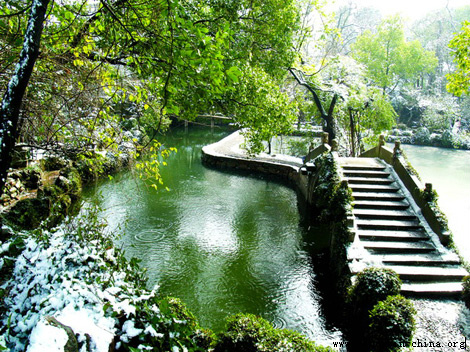| Home > Living In China |
A Leap of Faith: Buying Fresh Produce from a Chinese Market
Before I came to China, one of the first things I heard about was the live animal markets; a place, my colleague told me, where chickens and ducks were crammed into wooden crates, fish splashed about in tin buckets, and vendors wielded giant cleavers ready for your custom. During my first year living as an expat in Nanjing I never really crossed paths with this side of life in China, but over the past six months my mother-in-law has been instructing me in the purchase and preparation of wholesome, homemade Chinese cuisine.
Frozen food is generally unpopular in China as the Chinese believe the food loses its flavour the longer it is kept in an unnatural condition, so there is a high demand for fresh produce. In cities it is usually only fish and seafood which is bought live, due to the regular scares of Avian flu and the slaughter of whole poultry markets. Outside the cities though, you will be able to find street vendors standing with their clutch of chickens, or a fisherman with the day’s catch. The chickens you can find here are actually highly prized meat as they are reared over two to three years allowing them to mature to a desirable weight naturally, whilst living a semi-free-range existence, which improves the flavour. The chicken meat available in most cities often comes from overfed chickens.
Buying from a market is considerably cheaper than using a supermarket. In Nanjing, 500g of prawns will cost about 22 RMB from the market, compared to the frozen variety where 22 RMB got me only 230g. Prices vary according to the origin of the food you are buying. Seafood has to be transported from coastal cities such as Qingdao and Dalian, with a 24 hour deadline which raises the price, although if they come from within the province from smaller towns such as Taizhou, Qidong and Lianyungang they are a little cheaper.
Tips for buying fish
River fish are locally sourced, usually from smaller satellite towns within the province. Some of these fish are line caught, which raises the price, whereas others will be electrocuted en masse. My husband told me a story of how he was laying explosives on farmland in rural Jiangsu last year, which mistakenly rendered a whole fish farm brain dead. Rather than wasting good food, the workers decided to buy all the fish from the farmer and have a barbeque in the early hours of the morning.
Food safety is an important issue to consider when buying live food. Farmed fish are generally considered safer than river varieties as they are raised in clean water, whereas the rivers can be polluted giving the fish a strange flavour and can even make them poisonous. Another concern is the level of mercury in sea fish, which some studies have traced to Chinese coal-fired power stations. A report by the Taipei Veterans General Hospital claimed the problem was limited to deep-sea fish such as shark, as the large size of these fish increases their concentration of mercury. The report advised only to eat these types of fish once a month. Other studies have, however, contradicted the findings. An article by Chinese scientists, published in the journalEnvironmental Health Perspectives in 2010, found mercury levels in rice to be higher than those of fish (though that doesn’t mean mercury levels in fish are at a safe international level), during a study conducted in the inland province of Guizhou, which they dubbed ‘the mercury capital of China’.
Buying prawns and shellfish
When you buy live prawns or shellfish make sure to rake through the basket and throw out any dead ones. The freshest prawns have a transparent body; the more translucent they become, the older they are. They will then be bagged and weighed and you need to haggle the price. The price in a market varies throughout the day; higher prices are before meals, and lower prices can be found at the end of the day.
To check the quality of a fish you need to hold it by the tail and see how vigorously it flaps about – the more energy it has the fresher it is. Then check the body for any cuts or damage. Fish which are floating upside down in the tank are almost dead.
Haggling over the price of fish is difficult, as each variety has a different price tag. The only way to know the right price is to shop there regularly with someone experienced. If you discover you’ve massively overpaid, you can ask someone to go back with you and challenge the price, which my mother-in-law has done many times since I started shopping. You’ll need to take the item in question back with you so it can be re-weighed; markets will not give you a receipt so this exercise becomes more difficult than in a shop. In a supermarket there shouldn’t be a problem as the price is fixed.
Preparing crabs
In China most seafood, including fish, is cooked live. Crabs will often be sold with their claws tied together to avoid them pinching you, but be advised: they run quite fast if they escape. Last summer, as we were waiting for lunch, we heard the pitter patter of tiny feet as several hairy crabs made a bid for freedom having climbed out of the pot of boiling water and were sidestepping all over the kitchen, so remember to cover the pot with a lid. Live food will stay fresh for a day in the winter if stored in a bucket of water, but in the summer needs to be cooked the same day as there will be less oxygen in the water. If you’re keeping any live food in your house prior to cooking, be aware that it will try to escape. My mother-in-law keeps eels in the shower as they tend to jump out of the bucket and wriggle all over the floor.
Identifying fresh meat
Whilst beef and pork are rarely sold as live produce, the meat you find in markets will be very fresh and desirable cuts will sell out fast. The freshest meat is the reddest; the pinker it is, the older it is. Meat is often sold on the bone with all the fat intact, and this is how it will be weighed unless you are specifically buying a lean cut, which is more expensive. You can ask the butcher to remove the bones and excess fat for you after it has been weighed.
Learning to prepare food in the traditional Chinese style can be an interesting cultural experience. The frightening image conjured by my colleague before coming to China can sometimes still ring true though. Just a few months ago I stumbled upon a man skinning the bloody carcass of a large dog. It was a horrible sight and not something I ever want to see again, but to the people gathered about waiting for the meat it wasn’t a pet, but a farm-reared animal. It is important to know where your food comes from, and appreciate that something died to provide the meal on your plate. Visiting one of these markets is an experience in itself; even if you choose to buy nothing, you’ll take something away.
Custom
 more
moreWeb Dictionary
University
Zhuhai College of Jilin University
Huaibei Normal University
Beijing Information Science and Technology Unive...
Primary&secondary
Beijing No.9 Middle School
Wanjie zhaoyang School
The High School Affiliated to Renmin University ...
Language school
Beijing International Chinese College
Provide more comprehensive, professional and convenient services for...
Northeast Yucai Education Group
A public school providing primary education ranging from grade one o...
Guangdong Overseas Chinese Vocational School
The Chinese Educational Base, a foreign-oriented public institution....
Hobby School
Shaolin Temple South-and-North martial arts coll...
Established and developed by thirty-four generations of martial arts...
China Times
Its main undertakings include TCFL Training, TCFL Teacher Internatio...
Chopsticks Cooking Centre
Subjects include Chinese dishes from different regions, dim sums, lo...





 print
print  email
email  Favorite
Favorite  Transtlate
Transtlate 








